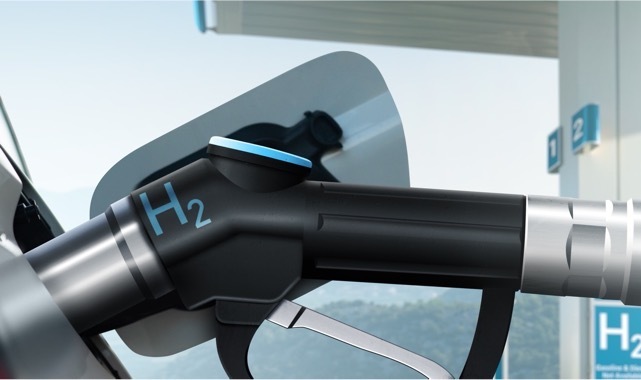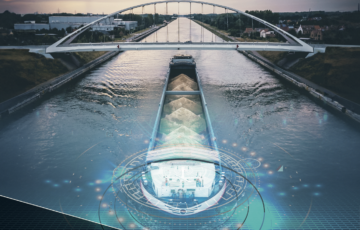The Next Normal: Driving Mobility Futures

Let’s take a moment and travel back to the year 1997. “Titanic” premiered in the US, Princess Diana and Mother Teresa died, and we were listening to the first MP3s while feeding our Tamagotchies. And not to forget: BWT started researching and investing in the H2 economy.
Now, in 2024, BWT FUMATECH is one of the world’s leading suppliers of proton exchange membranes and the corresponding membrane production technology, making it a player-to-watch in hydrogen power.
We cannot be sure precisely how the mobility of the future will develop, but one thing is certain: It will be different from what we mostly have today, and fuel cells will feature prominently. Faster, smarter, and greener: Hydrogen has already become an indispensable part of our future (energy needs) and is also gaining ground in the present. For instance, they can be used for the stationary case of energy and heat generation in houses, in transport applications, and for portable devices. Moreover, the application potential of fuel cells is key to success in the automobile sector.

So, the future of mobility is already here, driven by BWT FUMATECH.
Given the fact that the age of the electric car is upon us, manufactures and legislators alike have been pushing green mobility. Over the next few years, 89 European municipalities are set to invest roughly 1.8 billion euros in fuel cells for city buses, cars, and vans, in electrolysers for hydrogen production and in combined heat and power plants. The prognosis for this technology indicates that hydrogen, as a basis for a clean form of energy production, has one of the greatest impacts on countering climate change.
Which leads to the burning question: What are fuel cells cars?
Fuel cells are basically power plants that generate electricity from a chemical reaction between hydrogen and oxygen. Fuel cell cars are essentially mini power stations. The membrane fuel cell or PEM fuel cell (polymer electrolyte membrane) is often used and with great success. The heart of this fuel cell is a high-performance membrane produced by FUMATECH. A chemical reaction occurs that converts the hydrogen into electrical energy in the fuel cell, which then powers the vehicle. Hydrogen and oxygen combine in the fuel cell and that’s how energy is produced. The only waste product emitted during this process is water.

In other words: Fuel cells generate energy while hydrogen and batteries store it.
It could finally be time for the lightest element to power transport. A new dawn for hydrogen mobility in Europe is set: Last year, the European Union reached an agreement for the development of a hydrogen mobility ecosystem. With hydrogen stations every 200 kilometers on major roads, we all have a positive sign to push forward BWT’s pink mission to sustainability. The European Union is not alone in its support for hydrogen mobility: The USA and China both invest in climate funding, and Australia’s future vision is to have all new heavy vehicles use renewable fuels by 2040. These programs, in addition to those of Japan, South Korea, and other countries, include hydrogen mobility in the same way. The role of hydrogen will grow in the green energy system of the (near) future, as it can be produced from renewable energy and be stored and used in many areas – according to demand. Fuel cells consequently become major players, too.
BWT FUMATECH shares the vision of making a sustainable contribution to energy generation and formed a joint venture with the US-based global chemistry company “The Chemours Company”. “THE Mobility F.C. Membranes Company” supplies fuel cell and humidifier membranes globally, enabling downstream customers to accelerate conversion to green, hydrogen-powered heavy-duty transportation, driving green goals and sustainable policy frameworks in the E.U., the U.S. and around the world. "With this joint venture, we of course have a grand vision of accelerating the availability of resources necessary to empower more people, industries, and businesses to fully embrace a cleaner future," explains Andreas Weißenbacher, CEO of BWT.
Twenty years after the first public hydrogen station opened, and 27 years after BWT started researching and investing in the single most abundant substance in the universe, it’s time for the lightest element to power transport.
Latest insights & stories

DUURZAME LOGISTIEK
De visienota Goederenvervoer zet de Vlaamse ambities voor de verduurzaming van logistiek uit. Het hoofddoel is om een bereikbare regio te blijven en een veilig transportsysteem uit te bouwen, met een zo klein mogelijke impact op milieu en klimaat. Daarbij is het cruciaal dat we evolueren naar milieuvriendelijkere en energie-efficiëntere modi. We doen daarvoor een beroep op onze eigen kennis en ervaring, maar we verwelkomen ook internationale expertise.

De kijk van Proximus NXT
Co-creatie is het proces waarbij partners de krachten bundelen om samen waarde te creëren. Alleen ligt de focus bij co-creatie nog al te vaak op het proces zelf. En dat zet een rem op creativiteit en innovatie. Tania Defraine, Telco & Platforms Practice Lead bij Proximus NXT, is ervan overtuigd dat de echte meerwaarde van co-creatie in het menselijke aspect te vinden is. Anders gezegd: in de bedrijfscultuur.

SMART SHIPPING
Met een bevaarbaar waterwegennet van ruim 1.000 km is de binnenvaart in Vlaanderen een interessant alternatief voor industrieel vervoer over de weg. Met Smart Shipping willen we de efficiëntie van dat binnenvaartnetwerk verbeteren. Data-uitwisseling, logistieke innovatie en automatisatie van vaartuigen staan daarbij centraal. Maar onze vaarwegen en binnenvaart stoppen niet aan onze Vlaamse grenzen. Daarom is samenwerking met internationale partners essentieel.